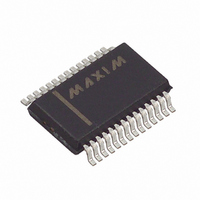MAX1757EAI+ Maxim Integrated Products, MAX1757EAI+ Datasheet - Page 14

MAX1757EAI+
Manufacturer Part Number
MAX1757EAI+
Description
IC BATTERY CHRG LI+ 28-SSOP
Manufacturer
Maxim Integrated Products
Datasheet
1.MAX1757EAIT.pdf
(17 pages)
Specifications of MAX1757EAI+
Function
Charge Management
Battery Type
Lithium-Ion (Li-Ion)
Voltage - Supply
6 V ~ 14 V
Operating Temperature
-40°C ~ 85°C
Mounting Type
Surface Mount
Package / Case
28-SSOP
Product
Charge Management
Operating Supply Voltage
6 V to 14 V
Supply Current
5 mA
Maximum Operating Temperature
+ 85 C
Minimum Operating Temperature
- 40 C
Charge Safety Timers
Yes
Mounting Style
SMD/SMT
Temperature Monitoring
Yes
Uvlo Start Threshold
2.4 V
Uvlo Stop Threshold
2.6 V
Lead Free Status / RoHS Status
Lead free / RoHS Compliant
cient voltage to fully drive the MOSFET gate even when
its source is near the input voltage.
The MAX1757 includes safety timers to terminate
charging and to ensure that faulty batteries are not
charged indefinitely. TIMER1 and TIMER2 set the time-
out periods.
TIMER1 controls the maximum prequalification time,
maximum full-charge time, and the top-off time. TIMER2
controls the maximum fast-charge time. The timers are
set by external capacitors. The typical times of 7.5 min-
utes for prequalification, 90 minutes for full charge, 45
minutes for top-off, and 90 minutes for fast charge are
set by using a 1nF capacitor on TIMER1 and TIMER2
(Figure 1).
FASTCHG, FULLCHG, and FAULT are open-drain out-
puts that can be used as LED drivers. FASTCHG indi-
cates the battery is being fast charged. FULLCHG
indicates the charger has completed the fast-charge
cycle (approximately 85% charge) and is operating in
voltage mode. The FASTCHG and FULLCHG outputs
can be tied together to indicate charging or done
(Figure 2). FAULT indicates the charger has detected a
charging fault and that charging has terminated. The
charger can be brought out of the FAULT condition
only by removing and reapplying the input power, or by
pulling SHDN low.
The intent of THM is to inhibit charging when the bat-
tery is too cold or too hot (+2.5°C ≤ T
using an external thermistor. THM time multiplexes two
sense currents to test for both hot and cold qualifica-
tion. The thermistor should be 10kΩ at +25°C and have
a negative temperature coefficient (NTC); the THM pin
expects 3.97kΩ at +47.5°C and 28.7kΩ at +2.5°C.
Connect the thermistor between THM and GND. If no
temperature qualification is desired, replace the ther-
mistor with a 10kΩ resistor. Thermistors by Philips/
BCcomponents (2322-640-63103), Cornerstone
Sensors (T101D103-CA), and Fenwall Electronics (140-
103LAG-RB1) work well. The battery temperature is
measured at a 1.12Hz rate (C
Charging is briefly halted to allow accurate measure-
ment.
If the temperature goes out of limits while charging is in
progress, charging will be suspended until the temper-
ature returns to within the limits. While charging is sus-
pended, the timers will also be suspended but will
Stand-Alone, Switch-Mode
Li+ Battery Charger with Internal 14V Switch
14
______________________________________________________________________________________
Charge Monitoring Outputs
TIMER1
= C
OK
TIMER2
Thermistor
≤ +47.5°C),
Timers
= 1nF).
continue counting from where they left off when charg-
ing resumes.
When SHDN is pulled low, the MAX1757 enters the
shutdown mode and charging is stopped. In shutdown,
the internal resistive voltage divider is removed from
BATT to reduce the current drain on the battery to less
than 5µA. The high-side power MOSFET switch is off.
However, the internal linear regulator (VLO) and the ref-
erence (REF) remain on. Status outputs FASTCHG,
FULLCHG, and FAULT are high impedance. When exit-
ing the shutdown mode, the MAX1757 goes to the
power-on reset state, which resets the timers and
begins a new charge cycle.
If the voltage on DCIN drops within 100mV of the volt-
age on BATT, the charger turns off. This prevents bat-
tery discharge by the charger during low input voltage
conditions.
VADJ sets the per-cell voltage limit. To set the VADJ
voltage, use a voltage-divider from REF to VADJ. A
GND-to-V
in the battery limit voltage. Since the full VADJ range
results in only a 10% change on the battery regulation
voltage, the resistor-divider’s accuracy need not be as
high as the output-voltage accuracy. Using 1% resis-
tors for the voltage dividers results in no more than
0.1% degradation in output-voltage accuracy. VADJ is
internally buffered so that high-value resistors can be
used. Set V
for R5 (Figure 1) from V
tery termination voltage is a function of the battery
chemistry and construction; thus, consult the battery
manufacturer to determine this voltage. Once the per-
cell voltage limit battery regulation voltage is deter-
mined, the VADJ voltage is calculated by the equation:
Table 2. Cell-Count Programming Table
Source Undervoltage Shutdown (Dropout)
Setting the Battery Regulation Voltage
V
REF
VADJ
CELL
GND
VADJ
Float
REF
change at VADJ results in a ±5% change
= (9.5 V
by choosing a value less than 100kΩ
BATTR
ADJ
Design Procedure
to GND. The per-cell bat-
/ N) - (9.0
CELL COUNT (N)
✕
1
2
3
V
Shutdown
REF
)








